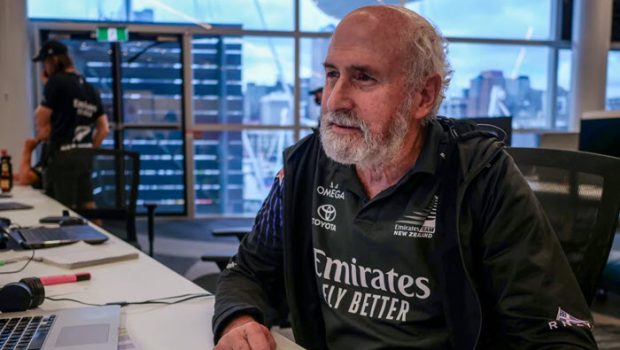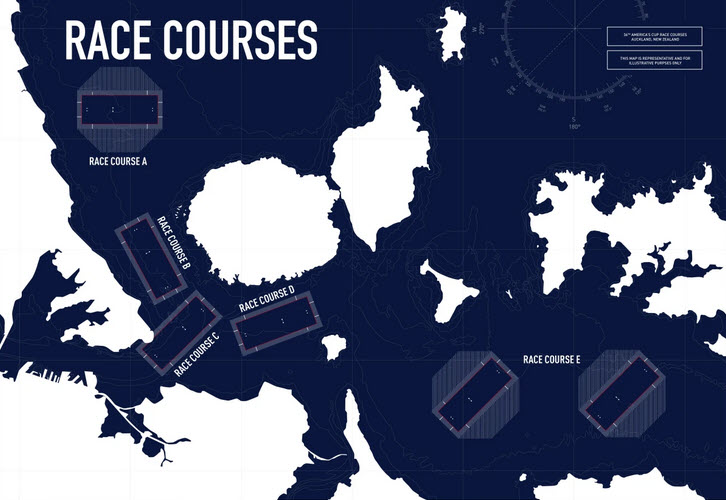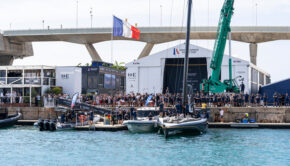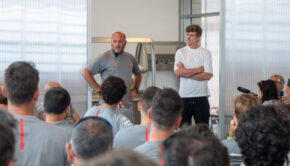Look at the bloody clouds, you idiots
Published on March 10th, 2021
The weather guru who’s helped Team NZ skippers call the shots for more than two decades hopes his final forecasts will be winners. Report by Suzanne McFadden:
When Te Rehutai glides into the America’s Cup start box, Clouds will be sitting on a hill somewhere overlooking the Hauraki Gulf, looking at, well, clouds.
Roger ‘Clouds’ Badham, Emirates Team New Zealand’s trusted weatherman for 21 years, prefers not to go out on the water.
From his vantage point up high, he can see a much bigger picture – reading the water and the sky to help Team NZ’s brains trust out on the racecourse make the crucial right decisions off the start-line.
Predicting what Auckland’s ever-changing weather will do next, Badham relays what he sees to Team NZ’s back-up helmsman and coach, Ray Davies, who’s on a chase boat right next to Te Rehutai. Up until five minutes before the pre-start dance begins, Davies can pass that knowledge on to Team NZ skipper Peter Burling and his afterguard.
“In Bermuda [in 2017], I had a favorite hill I went to every day, because there was only one racecourse. The trouble here is there are five bloody racecourses,” Badham says.
(A straight-talking kind of guy, he was given his nickname early in his 38-year Cup career, when he told sailors “Look at the bloody clouds, you idiots!”)
From North Head, Orakei or Castor Bay, Badham tries to co-ordinate ‘the big picture’ – taking what he sees, relating it to the wind observations on his computer and the guidance of the long-term weather models.
“You’re looking at a short-term forecast of how things are going to pan out for the first 30 minutes of the race,” he says. “It’s amazing how different it is on every one of the five racecourses.”
Clouds’ advice has been an essential part of Team NZ’s campaigns since 2000. The Australian weather guru, now in his early 70s, has a doctorate in numerical meteorology and the respect of the sailing world.
This is his 10th America’s Cup campaign – having started with Australian Alan Bond’s historic Cup victory in 1983. “And it’s my last one. Ten America’s Cups is enough,” he says.
Badham has been involved from the get-go of Team NZ’s campaign. “First guy in, one of the last standing,” he says. Weather models he’s collected over years on the Hauraki Gulf helped in the design of the AC75 foiling monohull and its many parts.
Badham was working in Auckland last summer until New Zealand went into Level 4 lockdown, and he managed to return home to New South Wales where he lives with his wife, Margaret.
For decades, Clouds has been legendary in the sailing world for guiding boats around the globe – like Grant Dalton’s record-setting Club Med – while at home deep in the Australian rainforest. He liked being completely surrounded by his 12 hectares of trees, unable to see the weather.
Three years ago, the Badhams moved to the small seaside of village of Coledale, just north of Wollongong. “I miss the privacy of the bush,” he says.
Even during the seven months he was back in Australia, Badham was able to provide Team NZ with forecasts every day.
“I reckon I could do 90 percent of my job from home. But the other 10 percent is the bit that you need most,” he says. Like sitting on a hill and watching the clouds.
The sailing fraternity is a close-knit bunch. In 1977, Badham was working as a meteorologist in Sydney, providing forecasts for Channel 7, when he made his first foray into the marine world, calling the weather for fellow Iain Murray’s successful 18ft skiff campaigns.
Today Murray is the America’s Cup race director, who gets to make calls on whether racing goes ahead based on the weather.
In 2000, after New Zealand’s successful Cup defence, Badham was headhunted by Team NZ head Tom Schnackenberg – they’d worked together on the winning Australia II challenge in ‘83. Team NZ wanted to get more scientific with their weather forecasting.
Signing up Badham was a major coup for the Kiwis – he’d had offers from six of the key players, with the biggest bid from the then second richest man on the planet, Larry Ellison, but chose Team NZ, who offered the least money.
Badham had a weather team of six for the 2003 America’s Cup in Auckland – including a young Ray Davies (Badham describes him today as the “underlying strength” of the Team NZ sailing team).
These days, Clouds is a one-man band.
Although racing in this Cup match doesn’t start until after 4pm, Badham starts each day at 6am to put together the first forecast of the day. He updates it for the team briefing at midday.
In the days when monohulls raced on the water – not above it – Badham’s job was more stressful.
“I could win and lose races more easily with the old slow boats, because I was involved before the start in calling the best side of the course and the strategy on the start,” he says. “Now the biggest stress is in terms of ‘moding’ the boat – calling which sails to use.”
Despite the first racing being on March 10, the race boats of Team NZ and challenger Luna Rossa had to declare on March 1 which hull, mast, foil arms, and rudder they would use throughout the match.
“We can’t change the foils like we could in Bermuda – where for every knot of windspeed, we had a different configuration. That was very stressful for me because I had to call it at seven o’clock in the morning for racing at two o’clock in the afternoon,” Badham explains.
“Now you’re just calling which mainsails and jibs to use, and how the track looks. They’re still big calls to get right. We saw a few times in the Prada Cup where boats weren’t dressed correctly – and it certainly had an impact on their performance.”
Anyone who’s sailed on Auckland’s waters know how tricky the wind, the tide and the current can all be. Badham is an expert at understanding how the complex topography of the city affects the way the breeze behaves.
“Everyone on the boat is across this, well and truly. Guys like Pete [Burling] and Blair [Tuke] have done a lot of sailing in this part of the world. But I can still help them,” says Badham, who’s also meteorologist for New Zealand’s Olympic sailing team.
He works with NIWA [National Institute of Water and Atmospheric], who provide oceanographic and atmospheric models solely for Team NZ. “We get a good tide model and a good wind model from them,” he says. “We use them every day. They’ve been great to work with.”
He also uses the live data coming off the PredictWind weather stations around the harbor. PredictWind, a Kiwi company run by former New Zealand Olympic sailor Jon Bilger, installed 14 new stations especially for the America’s Cup, to gather wind observations for all teams to use.
So to the question that everyone wants answered – from the sailors to the spectators: What does the weather hold for the America’s Cup match?
“The wind has certainly changed – March is a more unstable, dynamic type of month, compared to the stable pattern we had in February,” he says. “We’re in a La Niña pattern and it’s typical for that.
“We’ve got tropical activity to the north, and a few more frontal systems coming from the west. So we will have light winds and some pretty breezy days too.”
Knowing Auckland’s climate – where the wind tends to increase later in the afternoons – meant the Cup defender has set racing to start between 4pm and 6pm.
“We did that for a number of good reasons,” Badham says. “You often have quite soft winds in the middle of the day in Auckland. If you remember in the 2000 Cup, they sat off the East Coast Bays for a week trying to sail between 1pm and 3pm.” Four of nine racing days in that match – again between the Kiwis and Italians – were lost through a lack of wind.
“Generally, it’s best later in the afternoon, especially in the harbor when the west coast sea breeze comes in.”
It’s the challenge to keep getting the weather right that’s kept Clouds in the game this long. And in what may be his parting shot, the weather expert has a racecourse suggestion.
“Personally, I think a boat of this speed should be sailing a bigger course. My America’s Cup for this boat would start off Orakei Wharf and go round Tiri [Tiritiri Matangi Island],” he says.
And harking back to the first America’s Cup 170 years ago: “It would be the closest thing to around the Isle of Wight, wouldn’t it?”
More information:
• America’s Cup format, standings, and how to watch: click here.
• Complete America’s Cup coverage: click here
• Additional America’s Cup information: click here










 We’ll keep your information safe.
We’ll keep your information safe.